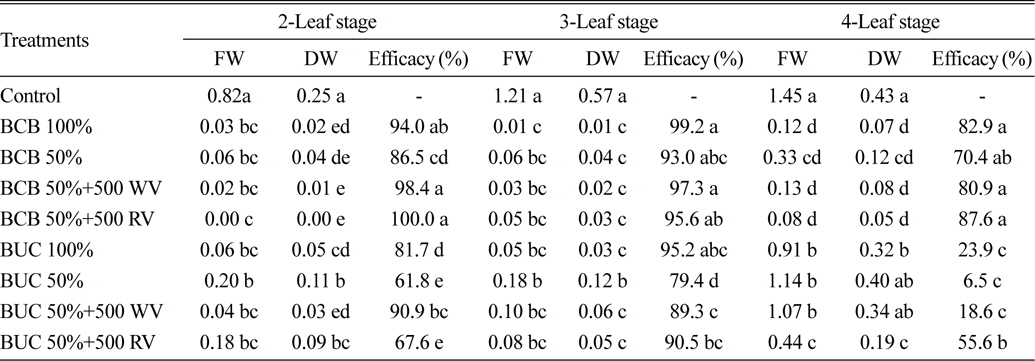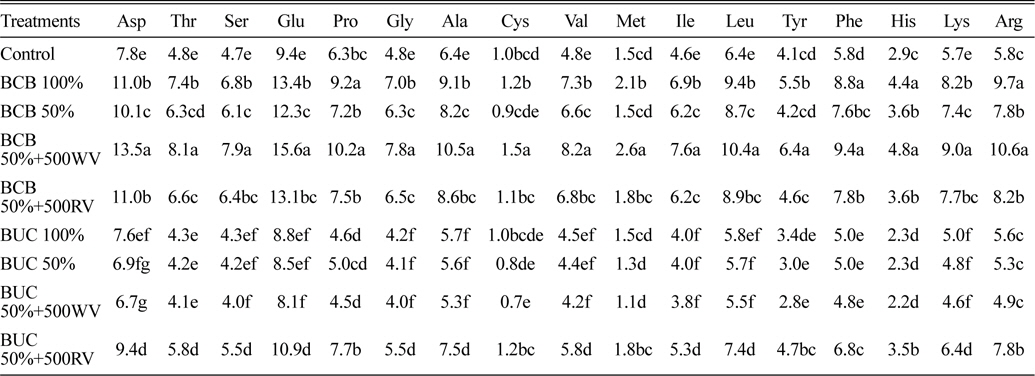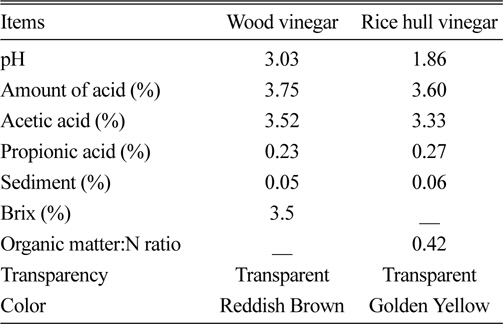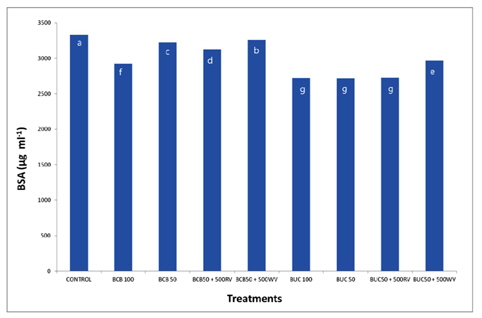



Barnyardgrass (
Alternate and integrated methods of weed control have continuously been sought. Bio-herbicides and/or allelochemicals may have potential to replace chemical herbicide or reduce chemical herbicide use. Morgan (1989) listed a few alternatives to chemical herbicide, which are weed (species) specific. The use of pyroligneous acids in agricultural production is also becoming popular in Asian countries. Pyroligneous acids are by-products of making charred-materials (“
Pyroligneous acid from wood (or wood vinegar) has been reported to have a promoting effect on growth and nutrient absorption of rice roots (Ichikawa and Ota, 1982). It also showed a degree of herbicidal activity (Mu et al., 2003) although according to Esguerra et al. (2009), it is impractical to use wood vinegar alone as a replacement for chemical herbicide. Pyroligneous acids can increase herbicide efficacy due to vast amounts of organic compounds present in it; most of which are organic acids, phenols, carbonyls, and alcohol (Kim et al., 2001). Acetic acid, the most potent component of wood vinegar has been used for weed control (Coffman et al., 2005). It was also found to be effective in controlling or killing below-ground vegetative propagules of fresh water plants e.g.
The purpose of this study is to determine the contribution of using pyroligneous acid in combination with commercial chemical herbicide for effective control of barnyardgrass (
>
Herbicides and pyroligneous acids tested
Pyroligneous acids were tested in combination with chemical herbicides to evaluate the herbicidal activity and its possible herbicidal effect for the control of barnyardgrass. Two commercial mixed-formulation herbicides namely: bentazone + cyhalof-butyl (BCB) and butachlor + clomazone (BUC), common herbicides used to control annual (broadleaf, sedges, and grasses) weeds in paddy rice fields of Korea were selected as chemical herbicide. Pyroligneous acids from wood (
[Table 1.] Physical and chemical components of pyroligneous acids.

Physical and chemical components of pyroligneous acids.
>
Treatments and experimental set-up
The experiment was conducted under greenhouse conditions at the Agricultural Experiment Station and Research Facility, College of Agriculture and Life Sciences, Kyungpook National University, Daegu, Korea from November 2010 to October 2011. Seeds of barnyardgrass (
>
Effect of treatment time/seedling stage
Seeds of barnyardgrass were germinated and transplanted as above mentioned. For this experiment set-up, BCB and BUC-pyroligneous acid treatments were applied at 2-, 3- and 4-leaf stages of
>
Fatty acid extraction and concentration
To evaluate the effects of pyroligneous acids-herbicide mixture on the fatty acid biosynthesis, the fatty acid composition of lipid extracts from
>
Protein extraction and quantification
To evaluate the effects of pyroligneous acids-herbicide mixture on amino acid and protein biosynthesis, shoots of
For the amino acid analysis, extraction was done by digesting 1.0 g oven-dried shoot samples in 10 ml 6 N HCl at 110℃, then vacuumed dried to removed HCl. Afterwards, 10 ml of 0.2M sodium citrate loading buffer (pH 2.2) was added. The mixture was filtered in 0.22 μm membrane filter and was subjected to Sep-pak plus C18 Cartridge to completely remove pigment and other high molecular material. Analysis was done using an amino acid auto analyzer (Biochrom 30, Biochrom Ltd., UK).
The experiments were laid out in a Completely Randomized Design (CRD) with 3 replicates. Data were analyzed using the Statistical Analysis System ver. 9.1 (SAS Institute, Cary, North Carolina, USA). The mean separation method used was Duncan Multiple Range Test (DMRT).
>
Effect of treatment time/seedling stage on herbicide-pyroligneous acid efficacy
Timing of application is vital, particularly when applying post-emergence herbicides. Streit et al. (2003) even emphasized that post-emergence is better than the preemergence control of weeds in a wheat field. In this study, the resulting dry weight of seedlings from herbicidepyroligneous acid treatments at two- and three-leaf stages was significantly lower compared to the control. Also, efficacy values were generally higher when treatments were done at two- and three-leaf stages compared with four-leaf stage. At two-leaf stage, we observed low herbicidal efficacies values but not significantly different from the full rate herbicide treatment when

Effect of treatment time/leaf-stage on herbicide-pyroligneous acid efficacies 21 days after treatmenta.
Eight (8) fatty acids were detected on

Percentage of fatty acids detected from shoots of E. crus-galli treated with wood vinegar (WV) and rice hull vinegar (RV) mixed with bentazone + cyhalofop-butyl (BCB) 21 days after treatmenta.

Percentage of fatty acids detected from shoots of E. crus-galli treated with wood vinegar (WV) and rice hull vinegar (RV) mixed with butachlor + clomazone (BUC) 21 days after treatmenta.
The changes in the proportion of fatty acids in the leaves of
>
Effect on protein and free amino acid contents
Protein contents in stressed-shoots or treated
A total of 17 free amino acids were detected in

Free amino acids (mg/g) in the shoots of E. crus-galli 3 days after treatment of bentazone+cyhalofop-butyl (BCB) and butachlor+clomazone (BUC) in mixture with WV and RVa.





